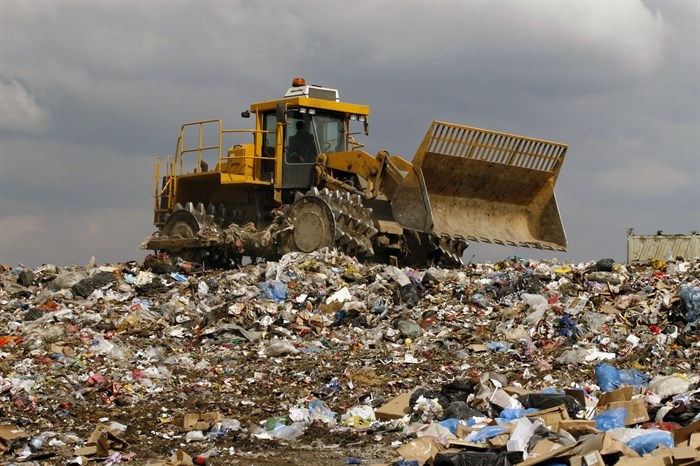
Tractor pushes garbage at landfill.
(JOHN MCDONALD / iNFOnews.ca)
June 28, 2020 - 2:30 PM
A huge trash pile abandoned by an insolvent waste-collection company on Green Mountain Road, within the Penticton Indian Reserve, could be cleared in three phases, according to the company that's taken on the project.
Kelly Sherman, president of the Ecora engineering and environmental services firm, sent out the update on work being done, noting that it's time to change the narrative about the controversial dumpsite to reflect the "actual situation"— the landowners are addressing this situation using plans developed by subject matter experts.
"It would be great to have PIB, ISC, RDOS, and the Municipality of Penticton be part of the solution and help contribute to addressing this problem," Sherman said in a press release issued Saturday, June 28.
"At no cost, Ecora developed a phased action plan for restoring the environmental quality and land use potential of the former Appleton operation. Our recommended approach will remove recyclable, inorganic and potentially hazardous materials, with the composting of clean organic materials on-site."
The three main phases of the plan are to prepare a purpose-built area for safe processing of the material, complete waste transfer and preliminary sorting and finally do a final sorting and decommissioning of the site.
"The detailed sorting operation will process the waste material into seven streams of off-site recycling, three streams of on-site composting, and five streams of off-site disposal," Sheman said.
Sherman said the failure of Appleton Waste Services left an area of mounded mixed waste, primarily construction and demolition debris, over an approximately 2,400 square metres on the Eneas Developments property.
Assuming the average height of the mound is five-metres and the average density of the waste is 0.28 tonnes per cubic meter (typical for C&D waste), the total mass of the mounded waste is 3,360 tonnes. Assuming a manual sort rate of six tonnes per hour, there are about 70 sorting days of remediation work to restore the site at eight hours per day.
Ecora's sorting plan:
Remediation of the mounded waste piles will occur in 3 Stages.
1. Sorting and Composting Site Preparation
A sorting and composting area will be prepared in the height-restricted area on the Penticton Airport approach path, approximately 175m to the southwest of the current storage area. Some shallow soils and vegetation will be stripped and stockpiled for intermediate and final cover, the site will be graded as not to receive surface water from offsite.
In the C&D area, the internal concrete barriers, fencing and other structures in the concrete compound will be removed to create as unobstructed a workflow as possible.
On completion, the compost area will be covered, graded and landscaped as to tie correctly in with the development plan.
2. Interim Waste Transfer and Preliminary Sorting
Wastes will be transferred from the current stockpiles along Green Mountain Road, to the sorting and composting areas to the southwest. The carboard in the concrete compound can be sorted to remove metals without asbestos precautions, wetted or shredded and composted.
Transfer of C&D waste piles will require asbestos precautions. Waste will be loaded to the bed of an articulated rock truck where it will be transported to the new sorting area and re-stockpiled to a maximum
3. Final Sorting and Waste Removal
The sorting process will involve mound spreading by an excavator in a thin row or fan, using trained labourers to separate wastes into distinct streams that will be managed separately.
Sorting tools may include pike poles to improve ergonomics and chainsaws to cut down beams, posts or poles that are unsafe to manage otherwise. Large debris will offset from the sorting pile and handled by skid steer to avoid lifting injuries, after the pile has been picked through. Site logistics will minimize travel from mixed wastes to separated containment. Large debris would require shredding prior to composting.
To contact a reporter for this story, email Kathy Michaels or call 250-718-0428 or email the editor. You can also submit photos, videos or news tips to the newsroom and be entered to win a monthly prize draw.
We welcome your comments and opinions on our stories but play nice. We won't censor or delete comments unless they contain off-topic statements or links, unnecessary vulgarity, false facts, spam or obviously fake profiles. If you have any concerns about what you see in comments, email the editor in the link above.
News from © iNFOnews, 2020